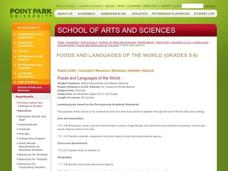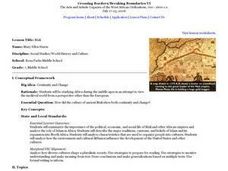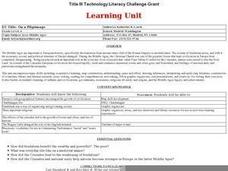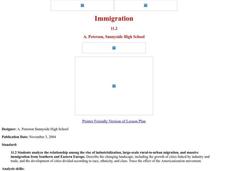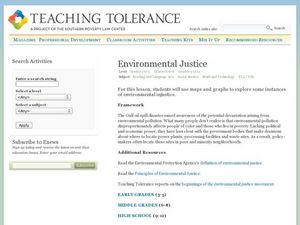Curated OER
Human Migration in the United States
Students investigate the factors involved in human migration in the United States. Students analyze maps of different regions in the United States to determine how a variety of factors influence human settlement and development.
Curated OER
United States & Canada: How Are We The Same? How Are We Different?
Students compare and contrast similarities and differences between Canada and the US. In this geography lesson, students read various articles and identify similarities and differences in economies, cultures, geography, climate,...
Curated OER
New York Times
Students explore current events. In this cross-curriculum lesson, students read and answer questions about the various articles included in the magazine.
Curated OER
Past and Present Turkey
Students compare and contrast modern-day Turkey with historical Ottoman culture. In this world civilization lesson, students create concept maps that allow them to compare the cultures, discuss leadership qualities, and create travel...
Curated OER
The Human Face of Flagstaff
Students make a brochure for Flagstaff, Arizona. In this geography lesson, students look at a map of Arizona and the Flagstaff Chamber of Commerce sheet to find natural and human features of the city. They create a brochure describing...
Curated OER
Where Is Xinjinag?
Pupils geographically recognize the territory of Xinjiang Province by identifying the physical landscape and important cities. They see how human rights issues have affected the global, political, and economic arena in Xinjiang.
Curated OER
Mary, Queen of Scots: Heroine or Harlot?
Young scholars explain how international politics, religion, and cultural beliefs influenced the life of Mary Queen of Scots. They watch a film about Mary, Queen of Scots and participate in a discussion and variety of extension activities.
Curated OER
Does Conflict Shape Nations? The Middle East
Young scholars locate settlements and observe patterns in the size and distribution of cities using maps, graphics, and other information. They explain the processes that have caused cities to grow.
Curated OER
Treasure Hunt - Geography and Cultural Diversity along the Journey to the West
Students work in groups and use treasure cards and maps to go on a treasure hunt to several regions in China. They prepare a presentation on the geography and culture of the area that they are assigned to.
Curated OER
The Rise of Islam
Young scholars read their textooks and discuss in groups the background of Muhammad answering oral questions and studying and identifying Mecca on the map. They work in groups to read handouts on "Early Revelations of Muhammad" to...
Curated OER
Foods and Languages of the World
Learners review Mexico's location and language and learn to pronouns 10 new Spanish food words. Students listen as the book, Corn is Maize is read, touching and passing around an ear of Indian corn. Learners discuss the contribution of...
Curated OER
Mali
Seventh graders begin the lesson by reading primary sources about the country of Mali. Using maps drawn in the past, they discuss what they can gather about the country from the map and how it has changed over time. They use a graphic...
Curated OER
On a Pilgrimage
Sixth graders engage in a variety of learning experiences surrounding the study of the Middle Ages. They construct a map of Europe, create a graphic organizer for the hierarchy of feudalism, design their own family crest, and write their...
Curated OER
Baltimoreans in the California Gold Rush
Eleventh graders explore the reasons for migration to California during the Gold Rush. For this American History lesson, 11th graders read letters about the opportunities and obstacles people faced. Students create a map of...
Curated OER
Gold Mountain
Learners read primary and secondary sources to find jobs as a Chinese immigrant. In groups they create a chart listing jobs for Chinese and write a letter about employment and living conditions to a Chinese friend.
Curated OER
Russia's Colony: Examining the Effects of Russian Colonization
Students respond to the question: How did Russian colonization effect Alaska's history? students examine environmental, cultural, economic, social and political impacts.
Curated OER
PERSONA PROJECT
Young scholars examine the role and influence of the major political, literary, and artistic figures in Russian history and in present-day Russia.
Curated OER
English Colonization
Fifth graders discuss their prior knowledge of what colonization means and give their opinions of why someone would want to start a colony. After recording their answers on web map they read about the English colonization in their books;...
Curated OER
Segregation in Prince Edward County
Eleventh graders examine the history of integration as it applied to Virginia high school in Prince Edward County. They evaluate a map of Virginia counties, read and analyze a first person narrative of a young girl involved in a boycott...
Curated OER
Immigration
Students explore the concept of immigration. For this immigration lesson, students read literature, analyze photographs, and evaluate political cartoons that reflect feelings about immigration in America during Industrialization....
Curated OER
So Far From the Bamboo Grove
Students read and discuss the book So Far From the Bamboo Grove. They select and reflect on the events that they consider most important in shaping their lives.
Curated OER
Ancient Mediterranean Lands: Rome
Seventh graders research ancient Roman civilizations, trade routes, aqueducts, and agriculture. In this Ancient Rome lesson plan, 7th graders view a picture of the Roman Aqueduct Pont du Gard and discuss its use in ancient Rome. Students...
Curated OER
Environmental Justice
Young scholars explore the concept of environmental stewardship. In this Gulf Oil Spill lesson, students discuss how environmental pollution affects those how live in poverty at a higher rate than those with more affluence. Young...
Curated OER
The First Ladies
Students compare two First Ladies. In this American history lesson, students read speeches given by Barbara Bush and Hillary Rodham Clinton. Students respond to questions about the speeches.










